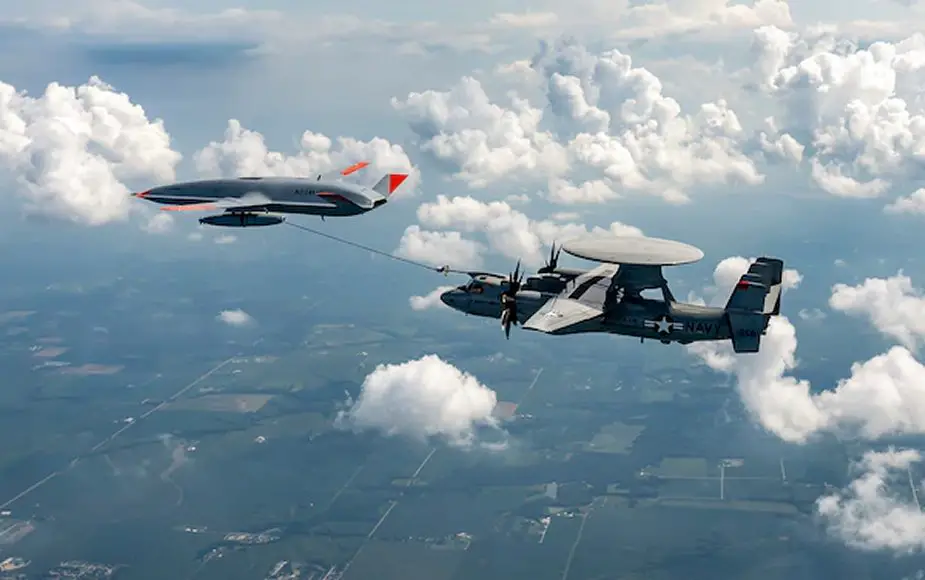Breaking news
MQ-25 conducts air-to-air refueling with E-2D Advance Hawkeye aircraft for first time.
According to information published by the U.S. Department of Defense on August 19, 2021, the Navy’s Unmanned Carrier Aviation program completed its first aerial refueling flight with an E-2D aircraft at Mid-America Airport in Mascoutah, Illinois.
Follow Navy Recognition on Google News at this link
 MQ-25 with E-2D Advance Hawkeye aircraft (Picture source: U.S. Navy)
MQ-25 with E-2D Advance Hawkeye aircraft (Picture source: U.S. Navy)
The Boeing-owned MQ-25 test asset, known as T1, transferred fuel to an E-2D Advanced Hawkeye, the newest variant of the E-2 platform which was upgraded with an aerial refueling capability in 2019.
This test marks the second refueling flight for the MQ-25 program. In June, the government/industry team completed the historic first unmanned tanking flight with an F/A-18 Super Hornet.
During the six-hour flight, Navy E-2D pilots from Air Test and Evaluation Squadron Two Zero (VX) 20 approached T1, performed formation evaluations, wake surveys, drogue tracking and plugs with the MQ-25 test asset at 220 knots calibrated airspeed (KCAS) and 10,000 feet. This test allows the program to analyze the aerodynamic interaction of the two aircraft. The team can then determine if any adjustments to guidance and control are required and make those software updates early, with no impact to the developmental test schedule.
T1 testing will continue over the next several months to include flight envelope expansion, engine testing, and deck handling demonstrations aboard an aircraft carrier before the MQ-25 engineering, manufacturing and development aircraft are delivered next year.
The ACCLW will integrate the MQ-25A Stingray into the carrier air wing alongside the E-2 and C-2 squadrons. The Stingray’s persistent mission tanking coupled with the E-2D’s aerial refueling capability will transform the Hawkeye from an over-the-horizon airborne early warning platform limited to shorter missions in the carrier environment, to an asset capable of providing comprehensive battle management for extended periods from anywhere within the battlespace.
The MQ-25A FIT is working with PMA-268 and Boeing to ensure the end user (MQ-25 operators) have early input as the aircraft moves quickly from development through test. The Navy will begin standing up the fleet replacement squadron, Unmanned Carrier-Launched Multi Role Squadron (VUQ) 10, later this year followed by two MQ-25A squadrons, VUQ-11 and 12. These squadrons will deploy detachments to the U.S. Navy’s aircraft carriers.
MQ-25 will be the world’s first operational carrier-based unmanned aircraft and provide critical aerial refueling and intelligence, surveillance and reconnaissance capabilities that will greatly expand the global reach, operational flexibility and lethality of the Carrier Air Wing and Carrier Strike Group. The Stingray is a foundational step toward the Navy’s strategic vision of a future fleet augmented by unmanned systems to pace the evolving challenges of the 21st century.
The E-2D Advanced Hawkeye is a high-wing airplane powered by two Rolls-RoyceT56-A-427A turboprop engines mounted on each wing and retractable tricycle landing gear. As with most carrier-borne airplanes, the E-2D is equipped with a tailhook for recovery (landing), and the nose gear can attach to a shuttle of the aircraft carrier's catapults for launch (takeoff). The aircraft also uses the Grumman Sto-Wing folding wing system for carrier storage. A distinguishing feature of the Hawkeye is its 24-foot (7.3 m) diameter rotating radar dome that is mounted above its fuselage and wings.


























